Economy

BEA: U.S. GDP Slowed Slightly in Fourth Quarter
Written by Peter Wright
April 2, 2018
U.S. GDP grew by 2.86 percent in fourth-quarter 2017. In its third estimate of GDP, the Bureau of Economic Analysis (BEA) revised the figure upward from its first estimate of 2.53 percent. While still positive, U.S. economic growth in the last quarter of the year showed a decline from the strong performance of the second and third quarters.
Economy.com reported: “U.S. GDP growth remained strong in the fourth quarter even before support from fiscal expansion kicked in. Real GDP grew 2.9 percent, modestly below the 3.2 percent in the third quarter, according to the third estimate from the BEA. Consumer spending dominated growth, accounting for most of the increase in GDP. Fixed investment and government growth also improved, while inventory accumulation slowed, and it and trade became drags on growth. Real disposable income grew a disappointing 1.1 percent, after rising 0.7 percent in the third quarter. The saving rate fell to 2.6 percent, its lowest rate since 2005. Profits fell 0.1 percent (not annualized), after rising 4.3 percent previously. Gross domestic income rose 0.9 percent after rising 2.4 percent in the third quarter.”
GDP is measured and reported in chained 2009 dollars, and on an annualized basis in the fourth quarter was $17.287 trillion. The growth calculation is misleading because it takes the quarter-over-quarter change and multiplies by four to get an annualized rate. This makes the high quarters higher and the low quarters lower. Figure 1 clearly shows this effect. The blue line is the trailing 12-months’ growth and the black line is the headline quarterly result. On a trailing 12-month basis, GDP was up by 2.58 percent in Q4, which was the best result since Q2 2015 and better than the 2.15 percent average in 32 quarters since Q1 2010. Therefore, we conclude that the current growth of U.S. GDP is better than its average for the last eight years.
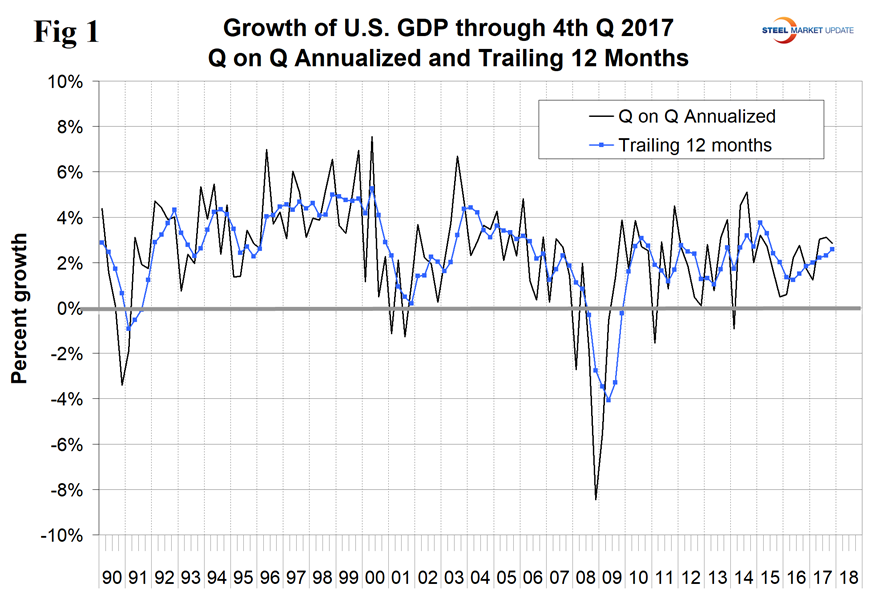
Figure 2 shows the headline quarterly results since 1990 and the July 2017 Congressional Budget Office forecast through 2022. Growth in the fourth quarter was better than the CBO forecast. The IMF forecasts global and national economic growth each April and October. In the October 2017 IMF update, the forecast of U.S. economic growth was revised down for each year through 2022. The 2017 growth forecast was revised from 2.31 percent down to 2.18 percent, while the 2018 forecast was adjusted from 2.52 percent down to 2.34 percent. Evidently, the IMF significantly underestimated the 2017 performance, and we expect an upward revision next month.
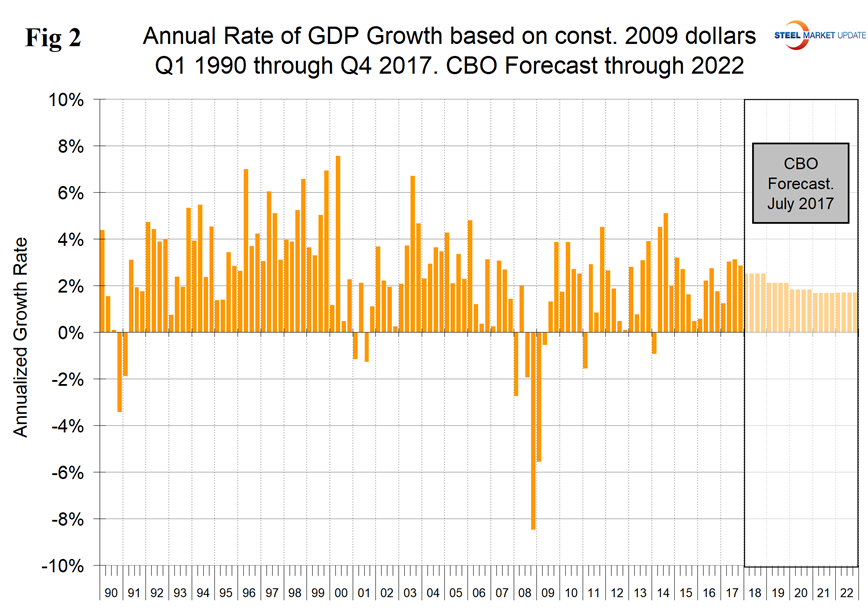
Figure 3 shows the change in the six major subcomponents of GDP in Q4 2017. Normally, personal consumption is the dominant growth driver, and this continued to be the case. Personal consumption includes goods and services, the goods portion of which includes both durable and non-durables. Inventories and the trade balance detracted from the fourth-quarter performance.
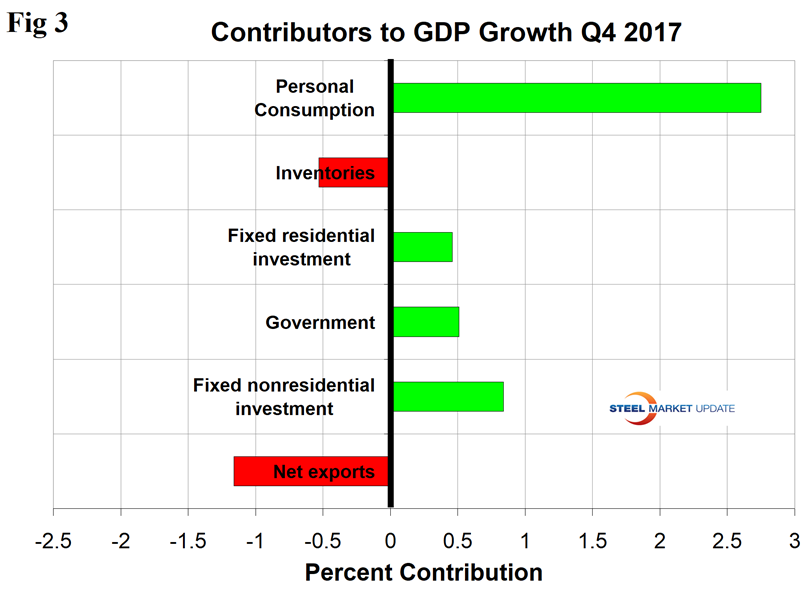
The contribution of inventories decreased from positive 0.79 percent in Q3 to negative 0.53 percent in Q4. Rising inventories are entered as a positive in the GDP calculation. Note that in the definitions at the end of this piece, inventories are not mentioned. Over the long run, inventory changes are a wash and simply move growth from one period to another. The contribution of personal consumption increased from 1.49 percent in Q3 to 2.75 percent in Q4. This was the best performance of personal consumption since Q4 2014. In the first three quarters of 2017, net exports made a positive contribution, influenced by the decline in the value of the dollar that continued through early September. We can expect this element of GDP growth to return to positive in the current quarter. The contribution of government expenditures was almost zero in the period Q2 2016 through Q3 2017 but made a 0.5 percent contribution in Q4.
Figure 4 shows the quarterly contributors of the six major subcomponents of GDP since Q1 2007. This chart clearly shows the whipsaw effect of inventory changes. Figure 5 shows the breakdown of the $18 trillion economy.
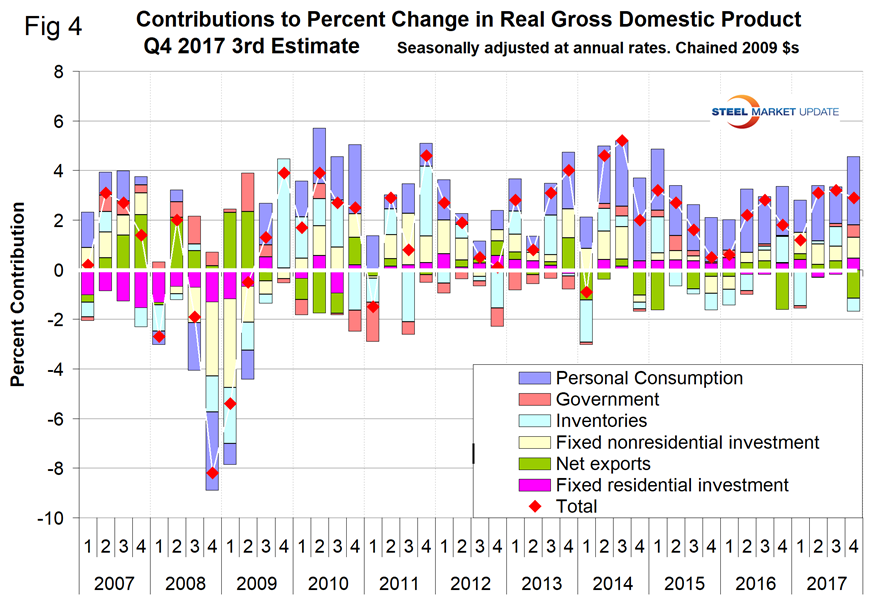
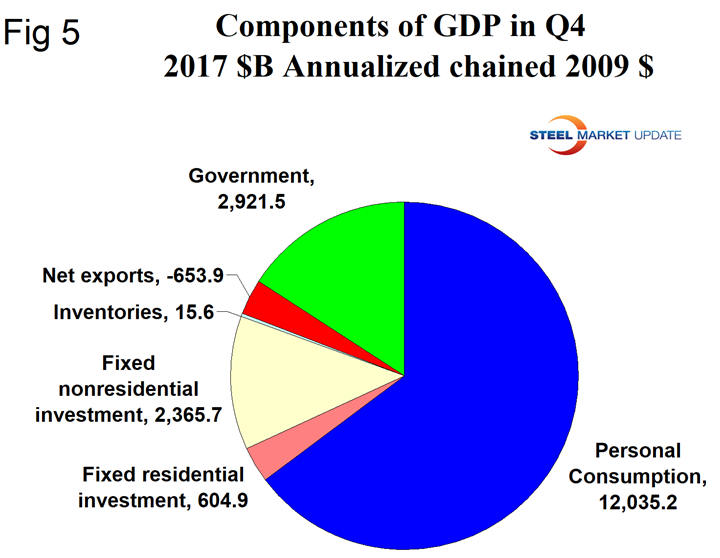
SMU Comment: Other than inventory contribution and trade, this was a good result, and we can expect the trade contribution to improve in Q1 2018. The trailing 12-month growth rate has improved for each of the last six quarters and in Q4 reached 2.58 percent. The U.S. is outperforming the IMF forecast made in October last year.
Definition of GDP: Gross domestic product (GDP) is the value of the goods and services produced by the nation’s economy less the value of the goods and services used up in production.
GDP is defined as Consumption (C) plus Investment (I) plus Government Spending (G) plus [Exports (E) minus Imports (I)] or: GDP = C + I + G + (E-I)
National savings is GDP minus (consumption plus government spending). That means that investment equals savings plus net exports. If there are no net exports, then money must come back into the U.S. from outside the country to finance investments, along with savings.
Thus, if there is a government deficit, there must be savings by both consumers and businesses, plus capital flows from outside the country, to offset that deficit for there to be any money left over for investments.
Another definition of GDP states that it equals the growth in working population multiplied by their productivity.

Peter Wright
Read more from Peter WrightLatest in Economy

New York state manufacturing index drops again in April
Firms were pessimistic, with the future general business conditions index falling to its second lowest reading in the more than 20-year history of the survey

Construction adds 13,000 jobs in March
The construction sector added 13,000 jobs, seasonally adjusted, in March, but tariffs could undermine the industry.

Supply chains, end-users brace for impact from tariffs
Supply chains are working through what the tariffs mean for them

ISM: Manufacturing expansion loses steam after two months of growth
US manufacturing activity slowed in March after two straight months of expansion, according to supply executives contributing to the Institute for Supply Management (ISM)’s latest report.

Chicago Business Barometer rose to 16-month high in March
The Chicago Business Barometer increased for the third-consecutive month in March. Despite this, it still reflects contracting business conditions, as it has since December 2023.
